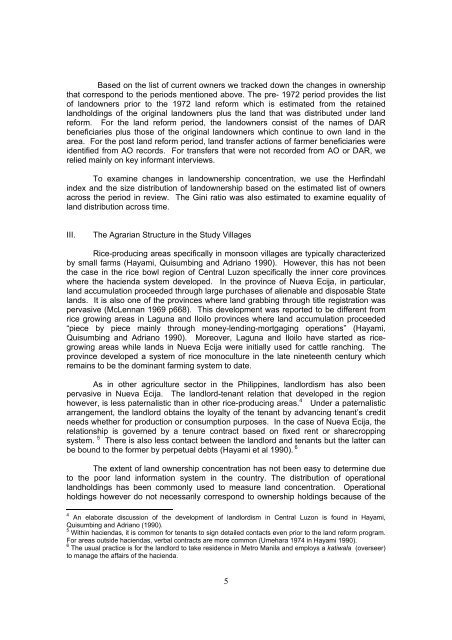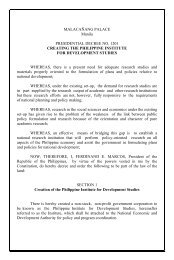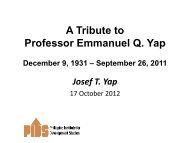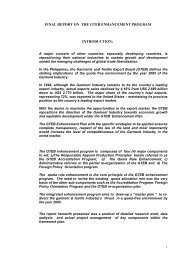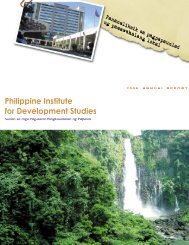being copies comments refinements necessarily
Land Reform and Changes in Land Ownership Concentration ...
Land Reform and Changes in Land Ownership Concentration ...
You also want an ePaper? Increase the reach of your titles
YUMPU automatically turns print PDFs into web optimized ePapers that Google loves.
Based on the list of current owners we tracked down the changes in ownershipthat correspond to the periods mentioned above. The pre- 1972 period provides the listof landowners prior to the 1972 land reform which is estimated from the retainedlandholdings of the original landowners plus the land that was distributed under landreform. For the land reform period, the landowners consist of the names of DARbeneficiaries plus those of the original landowners which continue to own land in thearea. For the post land reform period, land transfer actions of farmer beneficiaries wereidentified from AO records. For transfers that were not recorded from AO or DAR, werelied mainly on key informant interviews.To examine changes in landownership concentration, we use the Herfindahlindex and the size distribution of landownership based on the estimated list of ownersacross the period in review. The Gini ratio was also estimated to examine equality ofland distribution across time.III.The Agrarian Structure in the Study VillagesRice-producing areas specifically in monsoon villages are typically characterizedby small farms (Hayami, Quisumbing and Adriano 1990). However, this has not beenthe case in the rice bowl region of Central Luzon specifically the inner core provinceswhere the hacienda system developed. In the province of Nueva Ecija, in particular,land accumulation proceeded through large purchases of alienable and disposable Statelands. It is also one of the provinces where land grabbing through title registration waspervasive (McLennan 1969 p668). This development was reported to be different fromrice growing areas in Laguna and Iloilo provinces where land accumulation proceeded“piece by piece mainly through money-lending-mortgaging operations” (Hayami,Quisumbing and Adriano 1990). Moreover, Laguna and Iloilo have started as ricegrowingareas while lands in Nueva Ecija were initially used for cattle ranching. Theprovince developed a system of rice monoculture in the late nineteenth century whichremains to be the dominant farming system to date.As in other agriculture sector in the Philippines, landlordism has also beenpervasive in Nueva Ecija. The landlord-tenant relation that developed in the regionhowever, is less paternalistic than in other rice-producing areas. 4 Under a paternalisticarrangement, the landlord obtains the loyalty of the tenant by advancing tenant’s creditneeds whether for production or consumption purposes. In the case of Nueva Ecija, therelationship is governed by a tenure contract based on fixed rent or sharecroppingsystem. 5 There is also less contact between the landlord and tenants but the latter canbe bound to the former by perpetual debts (Hayami et al 1990). 6The extent of land ownership concentration has not been easy to determine dueto the poor land information system in the country. The distribution of operationallandholdings has been commonly used to measure land concentration. Operationalholdings however do not <strong>necessarily</strong> correspond to ownership holdings because of the4 An elaborate discussion of the development of landlordism in Central Luzon is found in Hayami,Quisumbing and Adriano (1990).5 Within haciendas, it is common for tenants to sign detailed contacts even prior to the land reform program.For areas outside haciendas, verbal contracts are more common (Umehara 1974 in Hayami 1990).6 The usual practice is for the landlord to take residence in Metro Manila and employs a katiwala (overseer)to manage the affairs of the hacienda.5


